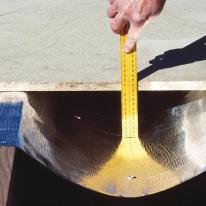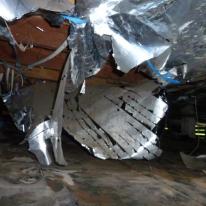Subfloor – reflective foil only installed
Listed under: insulation, Subfloor, wind
Cause
Reflective foil was commonly used when the house was built; the foil has become dirty and tarnished which reduces its effectiveness
Repair
-
retrofitting or repairing foil insulation under floors has been banned. Switch off the electricity at the switchboard before removing any existing foil – in some cases people have been electrocuted when staples used for fixing foil have pierced electrical cables
-
select an new insulation product specifically designed for use under floors. Proprietary products include polystyrene friction-fitted between the joists, and segments such as polyester, glass wool or sheep’s wool that come with tabs for fixing, or are held in place by strapping
-
the subfloor space, framing timber and underside of the floor should all be dry when installing insulation
-
ensure the insulation is pressed firmly against the underside of the floor. There should be no gaps (and no air movement) between insulation and floor and between sections of insulation
-
exposed subfloors may require sheet material fixed under the insulation to hold it firmly in place
-
where polystyrene is used, to be conservative, keep it separated from any PVC electrical cables that run under the floor with ducting or tape around the cables
-
all private rental properties must have thermal insulation installed in ceilings and under suspended floors where it is reasonably practicable to install it. This is a requirement under the Healthy Homes standards
-
while you are working under a house, it is a good idea to also put insulation around any hot water pipes that run under the floor. Insulating foam tubes with a slit along one side can be pressed over the piping.
Cause
Foil is damaged (usually by wind); there is no still air space between foil and floor – air blowing through the gap makes insulation ineffective
Repair
-
retrofitting or repairing foil insulation under floors has been banned. Switch off the electricity at the switchboard before removing any existing foil – in some cases people have been electrocuted when staples used for fixing foil have pierced electrical cables
-
select an new insulation product specifically designed for use under floors. Proprietary products include polystyrene friction-fitted between the joists, and segments such as polyester, glass wool or sheep’s wool that come with tabs for fixing, or are held in place by strapping
-
the subfloor space, framing timber and underside of the floor should all be dry when installing insulation
-
ensure the insulation is pressed firmly against the underside of the floor. There should be no gaps (and no air movement) between insulation and floor and between sections of insulation
-
exposed subfloors may require sheet material fixed under the insulation to hold it firmly in place
-
where polystyrene is used, to be conservative, keep it separated from any PVC electrical cables that run under the floor with ducting or tape around the cables
-
all private rental properties must have thermal insulation installed in ceilings and under suspended floors where it is reasonably practicable to install it. This is a requirement under the Healthy Homes standards
-
while you are working under a house, it is a good idea to also put insulation around any hot water pipes that run under the floor. Insulating foam tubes with a slit along one side can be pressed over the piping.






